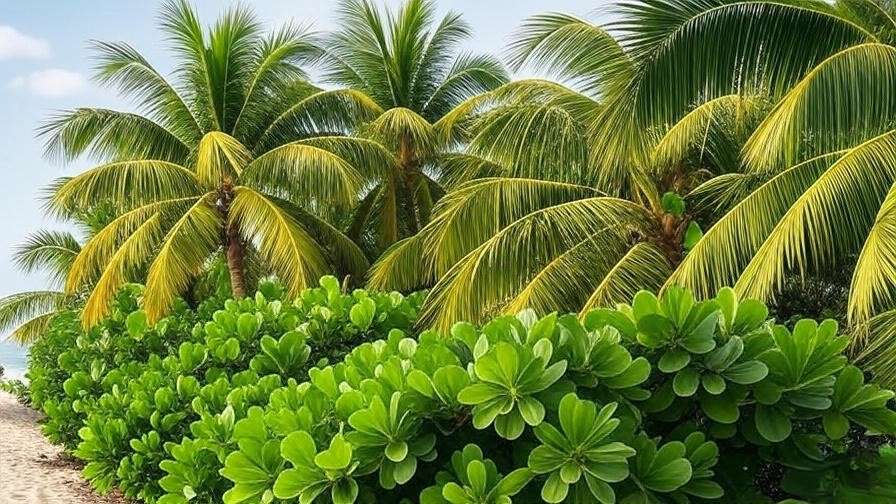Picture this: a warm Miami evening, the sun dipping below the horizon, casting golden hues across a row of majestic palm trees swaying gently in the tropical breeze. Miami Florida palm trees are more than just plants—they’re icons of South Florida’s vibrant culture and lush landscapes. Yet, keeping these tropical beauties thriving in Miami’s unique climate can be a challenge. From scorching sun to sudden storms, palm trees face conditions that demand expert care. As a horticulturist with over a decade of experience in South Florida’s plant care scene, I’ve crafted this comprehensive guide to help homeowners, landscapers, and plant enthusiasts ensure their Miami Florida palm trees flourish. In this article, we’ll cover everything from selecting the right species to mastering planting, maintenance, and pest control—ensuring your palms stay vibrant year-round. 🌿
Why Miami Florida Palm Trees Are Unique 🌴
The Role of Palm Trees in Miami’s Landscape
Palm trees define Miami’s aesthetic, lining boulevards, shading backyards, and framing beachfront properties. Species like the Royal Palm, Coconut Palm, and Sabal Palm (Florida’s state tree) are synonymous with the city’s tropical charm. They provide shade, enhance property value, and create a sense of paradise. According to the University of Florida’s IFAS Extension, palms are among the most planted ornamental trees in South Florida, with over 50 species thriving in the region’s climate.
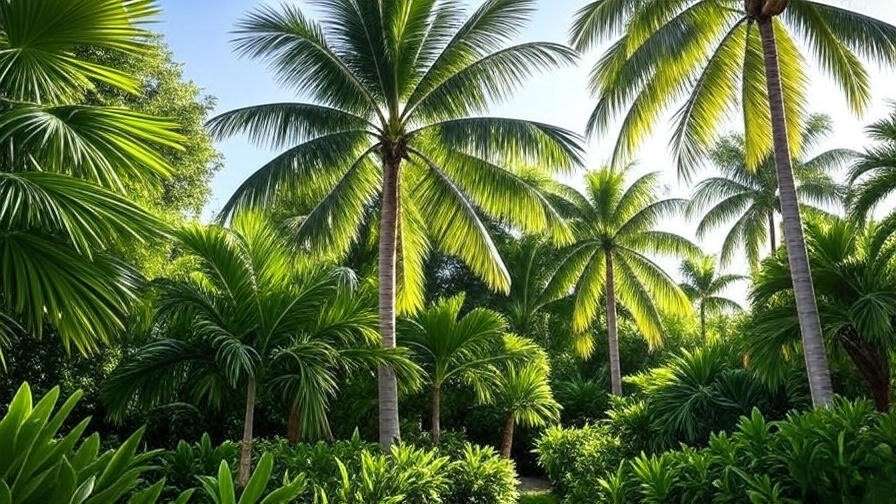
Challenges of Growing Palm Trees in Miami’s Climate
Miami’s subtropical climate—hot, humid, and prone to heavy rains—creates a unique environment for palm trees. Average temperatures range from 70°F in winter to 90°F in summer, with humidity often exceeding 80%. The sandy, well-draining soils common in Miami can lack essential nutrients like potassium and magnesium, which palms crave. Coastal properties also face salt spray, which can stress certain species. Additionally, hurricanes and tropical storms pose risks, potentially damaging young or poorly maintained trees. Understanding these challenges is the first step to successful palm care.
Choosing the Right Palm Tree for Your Miami Garden 🌿
Top Palm Tree Species for Miami
Selecting the right palm tree is crucial for long-term success. Here are some popular species for Miami Florida palm trees, along with their characteristics:
- Royal Palm (Roystonea regia): Tall and stately, reaching 50-80 feet. Ideal for large spaces but requires ample sunlight and regular fertilization.
- Coconut Palm (Cocos nucifera): Iconic and fruit-bearing, growing 40-60 feet. Thrives in coastal areas but needs protection from cold snaps.
- Areca Palm (Dypsis lutescens): A clumping palm, perfect for privacy screens. Grows 15-25 feet and tolerates partial shade.
- Foxtail Palm (Wodyetia bifurcata): Compact and ornamental, reaching 20-30 feet. Low-maintenance and drought-tolerant once established.
- Sabal Palm (Sabal palmetto): Hardy and native, growing 30-50 feet. Highly resistant to storms and salt.
| Species | Height | Sunlight | Salt Tolerance | Best Use |
|---|---|---|---|---|
| Royal Palm | 50-80 ft | Full Sun | Moderate | Focal point |
| Coconut Palm | 40-60 ft | Full Sun | High | Coastal landscapes |
| Areca Palm | 15-25 ft | Partial Shade | Low | Privacy screen |
| Foxtail Palm | 20-30 ft | Full Sun | Moderate | Ornamental |
| Sabal Palm | 30-50 ft | Full/Partial Sun | High | Native landscaping |
Factors to Consider When Selecting a Palm
Before planting, assess your space. Large palms like Royals need room to spread, while smaller Arecas suit compact yards. Consider sunlight—most palms thrive in full sun, but some, like Arecas, tolerate shade. Coastal homeowners should prioritize salt-tolerant species like Coconut or Sabal Palms. Finally, think about maintenance. If you prefer low-effort trees, Foxtails or Sabals are excellent choices.
Planting Your Palm Tree: Best Practices for Success 🌱
When and Where to Plant
The best time to plant Miami Florida palm trees is spring or early summer, allowing roots to establish before cooler months. Choose a location with well-draining soil and adequate sunlight (6-8 hours daily for most species). Ensure enough space for the tree’s mature size—Royal Palms, for example, need 15-20 feet of clearance. Avoid areas prone to standing water, as palms are susceptible to root rot.
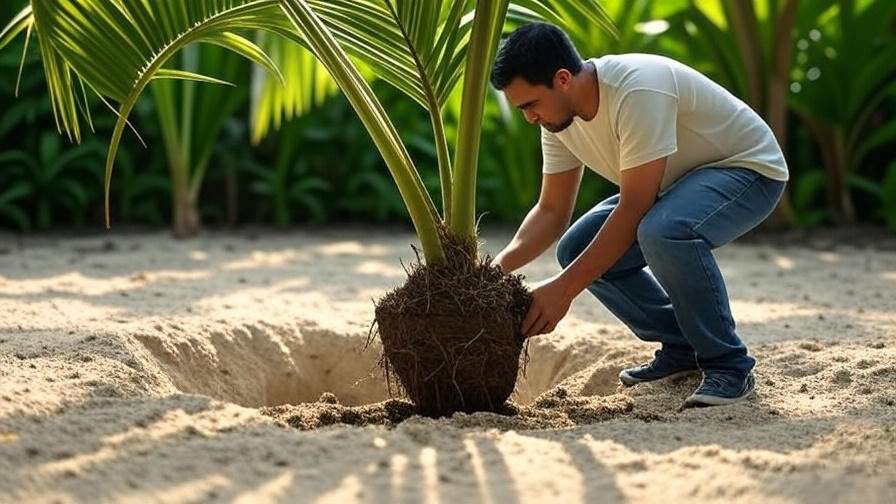
Step-by-Step Planting Guide
- Test the Soil: Check pH (ideal range: 6.0-7.0) and amend with organic compost if needed.
- Dig the Hole: Make it twice as wide and as deep as the root ball.
- Position the Palm: Place the tree so the top of the root ball is level with the ground.
- Backfill: Use a mix of native soil and compost, tamping gently to remove air pockets.
- Water Thoroughly: Soak the area immediately after planting to settle the soil.
- Mulch: Apply a 2-3 inch layer of organic mulch (e.g., bark or wood chips) around the base, keeping it 6 inches from the trunk.
Common Planting Mistakes to Avoid
- Overwatering: Excess water leads to root rot. Water deeply but infrequently.
- Planting Too Deep: Burying the root ball too low can suffocate the tree.
- Ignoring Soil Quality: Poor soil lacks nutrients, stunting growth. Always test and amend.
Essential Care Tips for Healthy Miami Florida Palm Trees 🌞
Watering Requirements
Watering needs vary by species and age. Newly planted palms require daily watering for the first 2-3 weeks, then 2-3 times weekly for 6 months. Mature palms often rely on Miami’s rainfall (average 60 inches annually) but need supplemental irrigation during dry spells. Aim for 1-2 inches of water per week, ensuring the soil stays moist but not soggy. Overwatering is a common mistake—check soil drainage to prevent root issues.
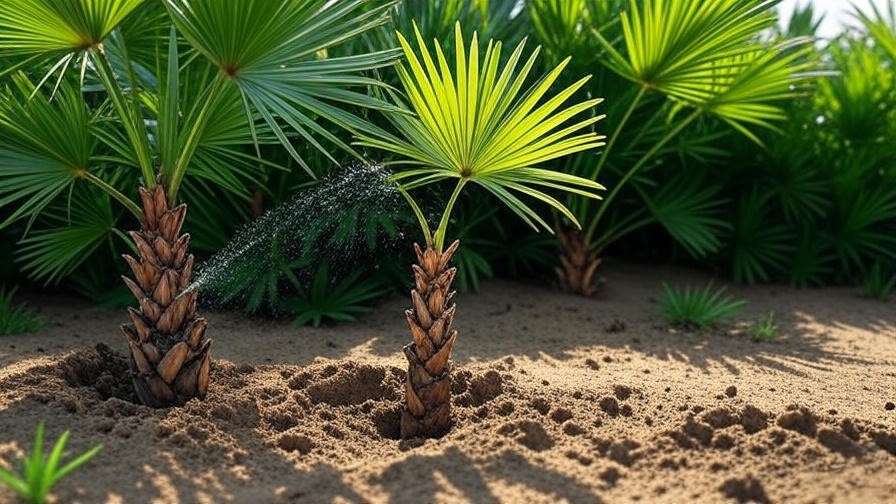
Fertilizing for Optimal Growth
Palms in Miami often suffer from nutrient deficiencies, particularly potassium and magnesium. Use a palm-specific fertilizer with an 8-2-12 ratio (nitrogen-phosphorus-potassium). Apply every 3-4 months during the growing season (March-October). Granular fertilizers work well, but liquid options can be used for quicker absorption. Look for signs of deficiency: yellowing fronds (nitrogen), orange spots (potassium), or yellowing at the base (magnesium). Always follow package instructions to avoid over-fertilization.
Pruning and Maintenance
Prune only dead, yellow, or damaged fronds to maintain health and aesthetics. Use clean, sharp tools and cut close to the trunk without damaging it. Avoid “hurricane pruning” (removing green fronds), as this stresses the tree. Clean the trunk periodically to remove debris or epiphytes, especially for Coconut Palms. Regular maintenance includes checking for loose fronds before storms to prevent hazards.
Protecting Your Palm Trees from Pests and Diseases 🐞
Common Pests in Miami
Miami’s warm climate attracts pests like:
- Red Palm Weevil: Burrows into the trunk, causing wilting. Look for holes or sawdust-like frass.
- Scale Insects: Small, waxy pests on fronds, causing yellowing. Treat with horticultural oil.
- Whiteflies: Tiny insects that weaken fronds. Use insecticidal soap for control.
Early detection is key. Inspect fronds and trunks monthly, especially during warmer months. Organic treatments like neem oil are effective, but severe infestations may require professional intervention.
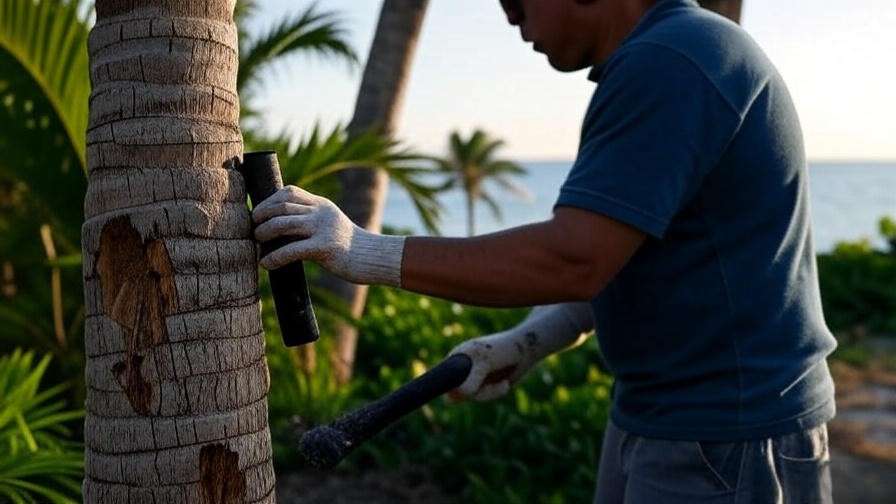
Diseases Affecting Miami Florida Palm Trees
Fungal diseases are a major concern:
- Bud Rot: Caused by fungi like Phytophthora, leading to wilting crowns. Prevent with proper drainage and avoid overhead watering.
- Lethal Yellowing: A bacterial disease spread by insects, causing frond drop and death. Choose resistant species like Sabal or Foxtail Palms.
Sanitation is critical—remove infected debris promptly. For lethal yellowing, consult a certified arborist for antibiotic treatments.
Storm Preparedness
Miami’s hurricane season (June-November) poses risks. Stake young palms to prevent toppling, and trim loose fronds before storms. After a hurricane, assess damage: remove broken fronds, check for trunk cracks, and water sparingly to aid recovery.
Expert Insights: Advanced Care Tips for Vibrant Palms 🌟
For those looking to elevate their palm care game, advanced techniques can make a significant difference. Dr. Maria Alvarez, a South Florida horticulturist with 15 years of experience, shares, “Miami’s climate is a double-edged sword for palms—ideal for growth but demanding for maintenance. Precision in care practices is key to vibrant, healthy trees.” Here are expert-level strategies to ensure your Miami Florida palm trees stand out:
- Soil Aeration: Compacted soil, common in Miami’s urban areas, restricts root growth. Use a soil aerator or pitchfork to loosen soil around the root zone every 1-2 years, improving oxygen flow and nutrient uptake.
- Drip Irrigation Systems: For consistent watering, install a drip irrigation system tailored to your palm’s needs. This ensures even moisture distribution, especially for newly planted or drought-sensitive species like Areca Palms.
- Sustainable Practices: Incorporate organic compost or slow-release fertilizers to reduce chemical runoff into Miami’s waterways. Avoid over-fertilizing, which can harm both the tree and the environment.
- Microclimate Management: In coastal areas, create windbreaks using hedges or fences to shield palms from salt spray. For inland properties, group palms with other tropical plants to create a humid microclimate that mimics their natural habitat.
These advanced techniques, when applied correctly, can transform your palms into lush, thriving centerpieces. For tailored advice, consult local experts through the University of Florida’s IFAS Extension or a certified arborist.
Troubleshooting Common Palm Tree Problems 🔧
Even with the best care, Miami Florida palm trees can face issues. Below is a troubleshooting guide to address common concerns, ensuring your palms stay healthy:
| Symptom | Possible Cause | Solution |
|---|---|---|
| Yellowing fronds | Nitrogen deficiency or overwatering | Test soil for nutrients; adjust watering to ensure proper drainage. |
| Orange spots on fronds | Potassium deficiency | Apply a palm-specific 8-2-12 fertilizer; reapply every 3-4 months. |
| Browning frond tips | Salt burn or drought stress | Flush soil with water to remove salt; increase irrigation during dry periods. |
| Stunted growth | Poor soil quality or root damage | Amend soil with compost; check for root rot and improve drainage. |
| Wilting crown | Bud rot or pest infestation | Remove affected areas; apply fungicide for bud rot; inspect for pests. |
Reader Pain Points:
- “Why is my palm tree browning?” Browning often results from salt exposure (common in coastal Miami) or irregular watering. Flush the soil with fresh water and ensure consistent irrigation.
- “How do I revive a struggling palm?” Identify the issue (pests, nutrients, or water) using the table above. Address deficiencies promptly and consider a soil test for accurate diagnosis. Local resources like Miami-Dade County’s Extension Service can provide lab testing.
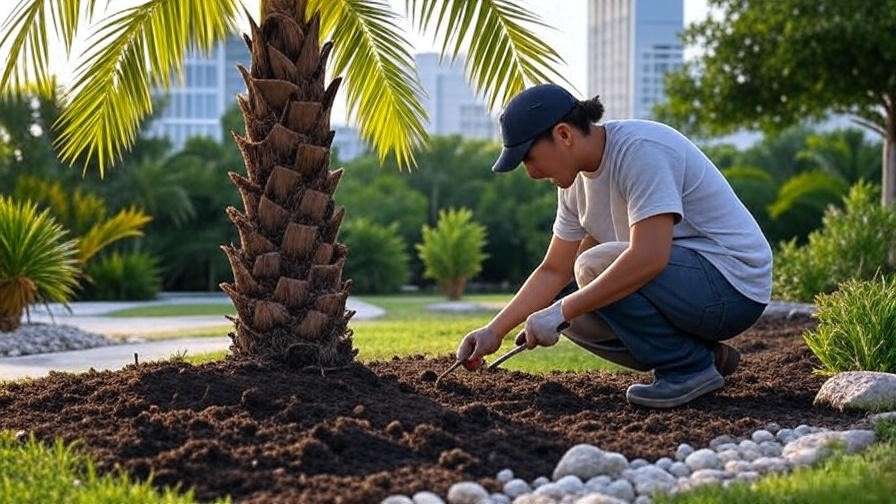
If problems persist, contact a professional arborist to assess your tree. Early intervention can save a struggling palm.
FAQs About Miami Florida Palm Trees ❓
How often should I water my palm tree in Miami?
Newly planted palms need daily watering for 2-3 weeks, then 2-3 times weekly for 6 months. Mature palms typically rely on Miami’s rainfall but require 1-2 inches of water weekly during dry spells. Always check soil moisture to avoid overwatering.
What’s the best fertilizer for Miami Florida palm trees?
Use a palm-specific fertilizer with an 8-2-12 ratio, high in potassium and magnesium. Apply every 3-4 months from March to October. Brands like Jobe’s or Miracle-Gro offer reliable palm formulas.
Can palm trees survive hurricanes in Miami?
Yes, especially hardy species like Sabal or Coconut Palms. Stake young trees, trim loose fronds before storms, and assess damage afterward. Avoid overwatering during recovery to prevent root stress.
How do I know if my palm tree is diseased?
Look for signs like wilting crowns, yellowing fronds, or trunk holes. Bud rot and lethal yellowing are common in Miami. Consult an arborist for diagnosis and treatment, especially for bacterial diseases.
Which palm trees are best for small yards in Miami?
Areca and Foxtail Palms are ideal for compact spaces, growing 15-30 feet and offering privacy or ornamental appeal. Ensure adequate sunlight and space for root growth.
Conclusion: Growing Lush, Healthy Palm Trees in Miami 🌴
Miami Florida palm trees are the heart of the city’s tropical allure, but they require dedicated care to thrive. By choosing the right species, planting correctly, and maintaining a consistent care routine—watering, fertilizing, pruning, and pest control—you can create a stunning tropical oasis in your yard. Protect your palms from Miami’s unique challenges, like nutrient-poor soils and hurricanes, with proactive measures and expert insights. Whether you’re a homeowner or a landscaper, these tips will help your palms flourish, boosting both beauty and property value.
Ready to make your Miami Florida palm trees the envy of the neighborhood? Start applying these care tips today! Share your experiences in the comments below, reach out to local experts for personalized advice, or explore our other articles on tropical plant care. 🌿 Want a quick reference? Download our free Miami Palm Care Checklist to keep your trees thriving year-round!

